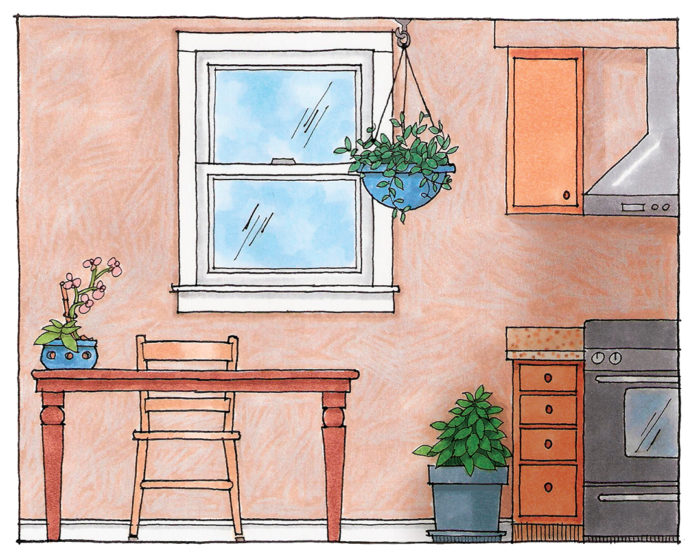
I started collecting houseplants in 1979, right about the time I found James Underwood Crockett’s houseplant book, Crockett’s Indoor Garden, at a garage sale for 50 cents. I was a college kid living in my first meager apartment with a few cuttings of philodendron, pothos, and grape ivy, taken from my mom’s breakfast nook, living on a windowsill. Crockett’s book became my plant bible, as I got started on houseplants and developed my love for plants in general.
As my plant collection grew, however, I realized there wasn’t enough indoor real estate to accommodate them all, and I started layering multiple plants together in one pot. Because of this layering, I realized that many houseplants, often from tropical origins, actually thrive when planted together because of the extra humidity that is generated. I also came to discover each plant’s cultural needs and what plants cohabitate best together.
Making houseplant combinations is like creating a still-life painting—only they are not still. They grow—something to consider when selecting plants. I am able to use my creative ability and pair texture, color, and size—all while having the plants take up less square footage in the room. This allows me to have more plants, which delights the collector in me. Easy-care houseplants enhance a room’s decor. And after working several hours a day, coming home to a welcoming green space can be essential to keeping you connected to nature.
Clean air is just a houseplant away
One of the healthiest things you can do for your home is fill it with houseplants. They not only add life to a room but also take out something you don’t want: toxic gasses. But not all indoor plants are created equal. A study, conducted by the National Aeronautics and Space Administration and the Associated Landscape Contractors of America, rated some houseplants as more efficient than others at removing toxins. Check out a few of the top-rated clean-air plants featured in these combos.
Even houseplants need adequate light. Consider things like the direction that the sun comes into your home, what kind of overhang your house has, and the shade from trees or buildings. All of these things—as well as blinds, ultraviolet window protection, and deciduous trees (which provide more light in fall and winter)—can change your lighting situation. To get the right amount of light, however, you first have to understand the three basic types of houseplant lighting needs:
Know your indoor plants’ lighting needs
• Low-light plants will do well in a north-facing window as they do not require any direct sunlight. Plants can also be placed in the interior of a room with moderate light from eastern, western, or southern exposures.
• Medium- or bright indirect–light plants like an east- or a west-facing window or should be placed at least 2 feet away from a south-facing window. A western exposure needs to provide indirect light through the morning and early afternoon; if it receives more intense light and becomes hotter in the afternoon, place the plant farther into the room.
• High-light plants should be placed in a south-facing window that provides the brightest light conditions for the longest time each day or in an unobstructed west-facing window that gets up to four to six hours of direct light in the afternoon. Make sure to check leaves for sunscald, and rotate pots for even plant growth.
A little chartreuse adds a lot of life
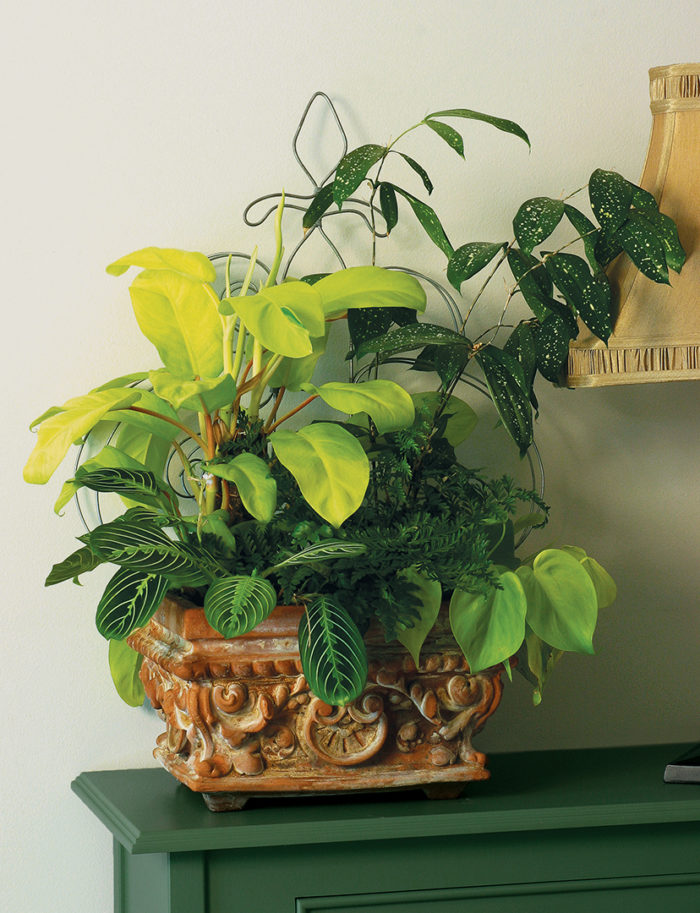
This French terra-cotta pot was a delight to fill with classic houseplants that have been kicked up a notch. Two updated versions of reliable philodendrons not only are easy to care for but also provide a bright backdrop of color, which highlights the prayer plant and the dracaena.
Using the galvanized fleur-de-lis pot trellis as support, ‘Golden Erubescens’ philodendron creates a fountain of golden light; it develops red stems and petioles for an extra layer of interest.
With the current craze for chartreuse-foliaged plants, ‘Aureum’ philodendron delivers a flashier show than a traditional trailing philodendron.
The chartreuse brings out the bright green midribs of ‘Marisela’ prayer plant and the spots on the leaves of ‘Florida Beauty’ dracaena. Stabilizing all that action-packed foliage is a glossy, fine-leaved ‘Austral Gem’ asplenium fern, giving the eye a place to rest for a moment.
1. ‘Austral Gem’ asplenium fern (Asplenium ‘Austral Gem’)
2. ‘Florida Beauty’ dracaena (Dracaena surculosa ‘Florida Beauty’)
3. ‘Marisela’ prayer plant (Maranta leuconeura ‘Marisela’)
4. ‘Golden Erubescens’ philodendron (Philodendron erubescens ‘Golden Erubescens’)
5. ‘Aureum’ philodendron ••• (Philodendron scandens ‘Aureum’)
Lighting conditions: Bright, indirect light
Lush greenery takes you to the tropics
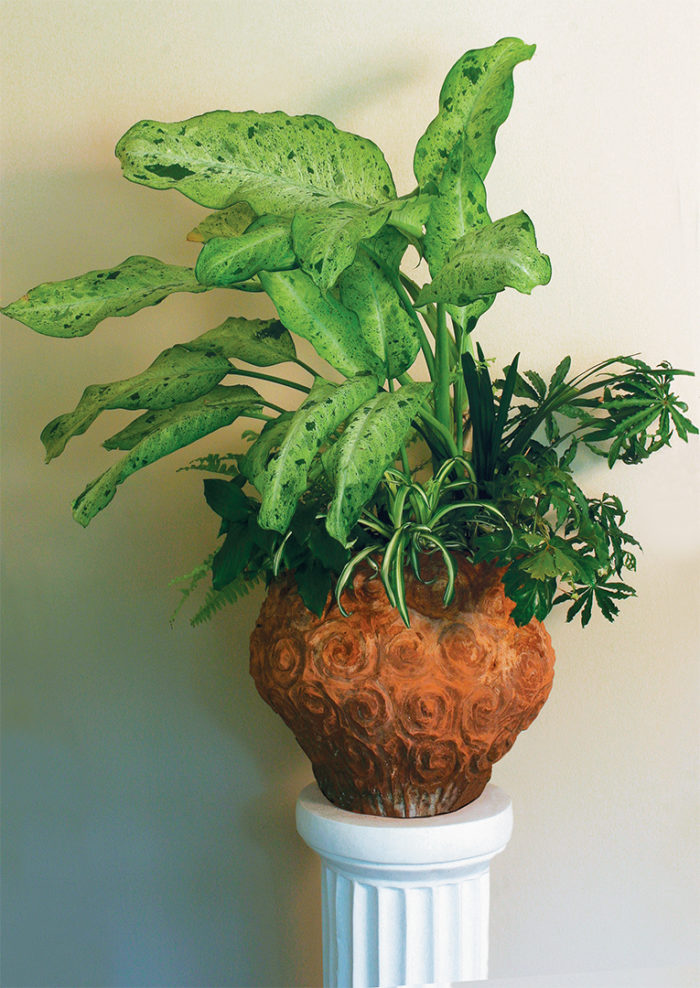
This handmade terra-cotta pot inspired a plant combination that looks like it could be found on a windswept beachfront after a storm. The plants are the more-exciting cousins of tried-and-true stalwarts of the indoor garden.
These plants can survive being watered once a week—with one exception: the Boston fern. When I have a plant that requires more water than the rest in a combo, I like to put a few soil polymers directly under it to keep that section of soil consistently moist.
1. ‘Tweed’ anthurium (Anthurium ‘Tweed’)
2. ‘China Star’ cast-iron plant (Aspidistra fungilliformis ‘China Star’)
3. ‘Jade Ribbons’ cast-iron plant (Aspidistra caespitosa ‘Jade Ribbons’)
4. ‘Bonnie’ spider plant (Chlorophytum comosum ‘Bonnie’)
5. ‘Ellen Danica’ oak leaf ivy (Cissus rhombifolia ‘Ellen Danica’)
6. ‘Camouflage’ dumb cane (Dieffenbachia ‘Camouflage’)
7. ‘Rita’s Gold’ Boston Fern (Nephrolepis exaltata ‘Rita’s Gold’)
Lighting conditions: Average, indirect light
Spice it up with a crazy combo
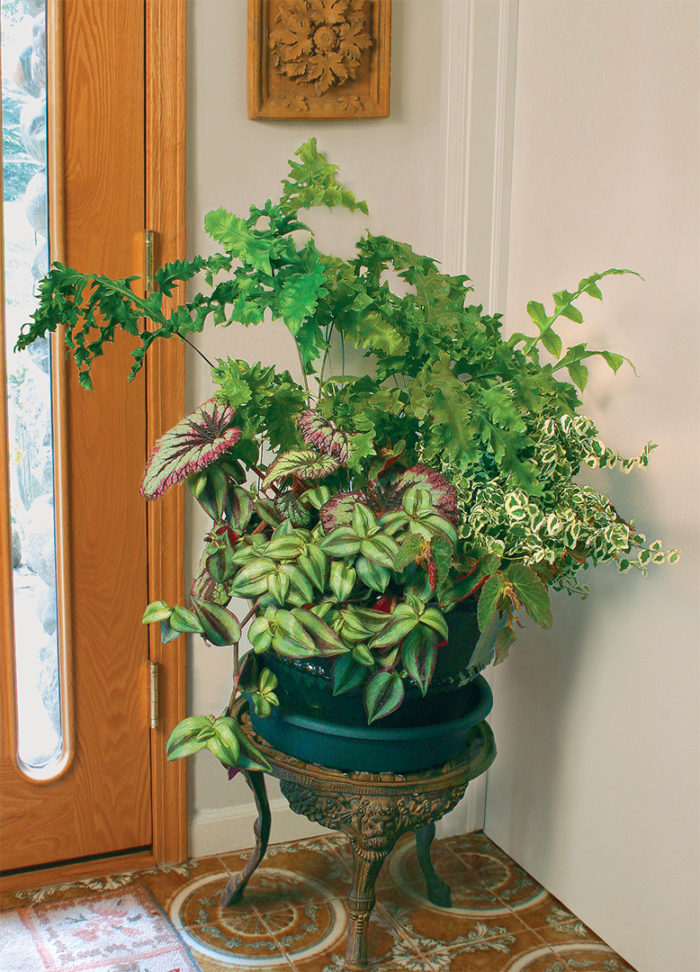
This combination delivers pattern with a punch—like a crazy uncle at a wedding wearing mismatched plaids, stripes, and polka dots who somehow manages to pull off the whole look with panache.
The old-fashioned Tradescantia acts as the workhorse, covering ground beneath the begonias, creeping fig, and fern. The blue tones found in many of the leaves complement the burgundy undersides of three of the plants. The plants’ multiple colors and patterns might be too much in a combo, but the soft texture of the feathery blue fern and the midnight blue glazed pot create a frame for all that foliage drama.
1. ‘Mandianum’ Bear’s paw fern (Polypodium aureum ‘Mandianum’)
2. ‘Brazilian Lady’ Begonia (Begonia ‘Brazilian Lady’)
3. ‘Fireworks’ rex begonia (Begonia ‘Fireworks’)
4. Variegated creeping fig (Ficus pumila ‘Variegata’)
5. Tradescantia (Tradescantia zebrina ‘Tricolor’)
Lighting conditions: Average, indirect light
Blue-toned plants make a splash
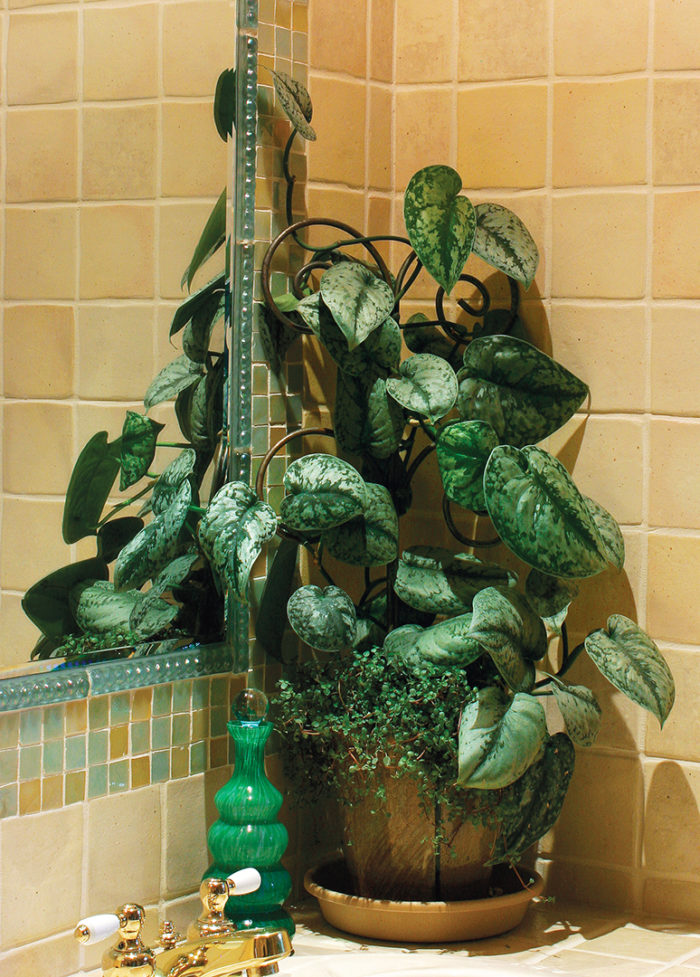
This bathroom with western exposure provides unlimited plant choices with its bright, indirect, late-day sun that filters into the room. A seaside-inspired decor, in shades of creamy taupe and aqua, set the stage for soft, blue-toned plants. ‘Silver Satin’ pothos lazily climbs up an aged-copper pot trellis, while pilea spills like tumbling water over the edge of a beige-washed pinstripe pot. The combination not only elegantly complements the decor but also soothes the soul of the home owner because it provides beauty but needs little care.
1. ‘Silver Satin’ pothos (Epipremnum aureum ‘Silver Satin’)
2. Pilea (Pilea glauca)
Lighting conditions: Bright, indirect light
SOURCES
The following mail-order plant sellers offer the widest selection of the houseplants featured:
• Asiatica nursery, Lewisberry, Pa.; 717-938-8677; www.asiaticanursery.com
• Glasshouse Works, Stewart, Ohio; 740-662-2142; www.glasshouseworks.com
• Logee’s Tropical Plants, Danielson, Conn.; 888-330-8038; www.logees.com
Julia Hofley’s houseplants share her home in Bloomfield Hills, Michigan.
Fine Gardening Recommended Products

Pruning Simplified: A Step-by-Step Guide to 50 Popular Trees and Shrubs
Fine Gardening receives a commission for items purchased through links on this site, including Amazon Associates and other affiliate advertising programs.

Planting in a Post-Wild World: Designing Plant Communities for Resilient Landscapes
Fine Gardening receives a commission for items purchased through links on this site, including Amazon Associates and other affiliate advertising programs.

Buffalo-Style Gardens: Create a Quirky, One-of-a-Kind Private Garden with Eye-Catching Designs
Fine Gardening receives a commission for items purchased through links on this site, including Amazon Associates and other affiliate advertising programs.


















Comments
Log in or create an account to post a comment.
Sign up Log in